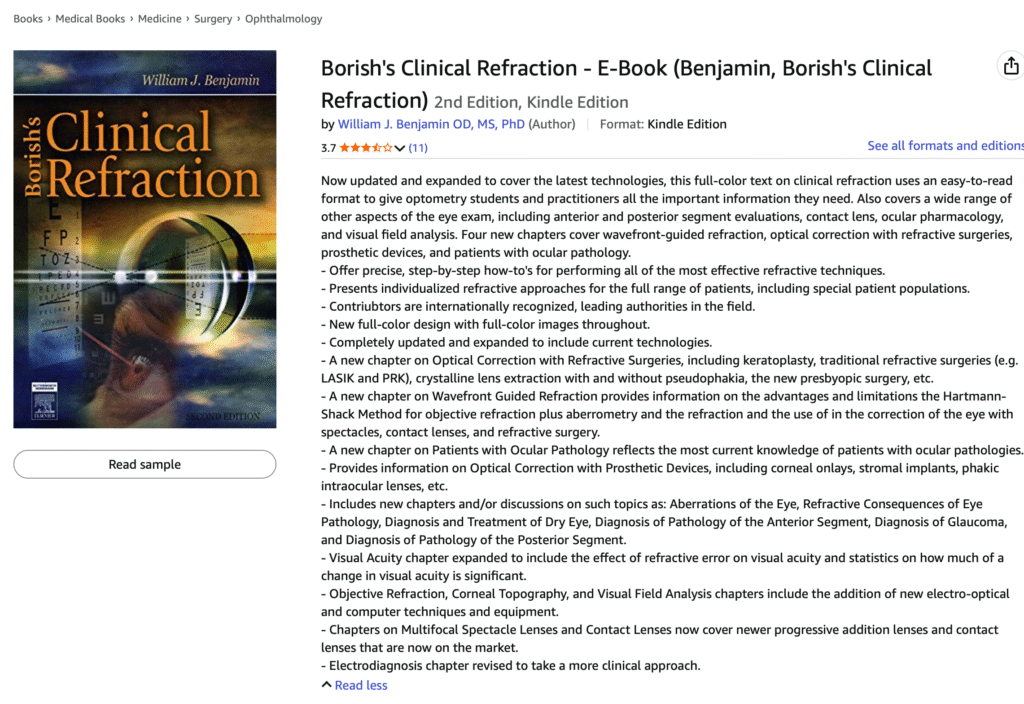Borish’s Clinical Refraction Second Edition
When one looks at the history of optometry, few works have shaped the profession as profoundly as Borish’s Clinical Refraction. From its earliest edition, it became a foundational text for generations of optometrists, anchoring their understanding of refractive eye care, optical correction, and clinical decision-making..

What’s New in the Second Edition
The Second Edition represents years of updated research, clinical findings, and educational advances. Every chapter has been revised, with some thoroughly expanded and others newly introduced.
Expanded and Significantly Revised Chapters
- Chapter 14: Posterior Segment Evaluation – updated with new imaging and diagnostic insights.
- Chapter 16: Clinical Electrophysiology – more practical, patient-focused applications.
- Chapter 22: Analysis, Interpretation, and Prescription for Ametropias and Heterophorias – refined for better accuracy.
- Chapter 25: Prescription of Absorptive Lenses – crucial for glare and light-sensitive patients.
- Chapter 30: Infants, Toddlers, and Children – deeper coverage of pediatric ametropia and prevention strategies.
- Chapter 34: Keratoconus and Irregular Astigmatism – key for modern lens designs and corneal conditions.
- Chapter 36: Patients with Low Vision – integrating new rehabilitation approaches.
The optics of contact lenses have been expanded into two separate, detailed chapters:
- Chapter 26: Applied Optics of Contact Lens Correction
- Chapter 27: Clinical Optics of Contact Lens Prescription
Entirely New Chapters
- Chapter 19: Wavefront Refraction – exploring the promise and current limitations of this new technology.
- Chapter 29: Refractive Surgery and Prosthetic Devices – candid discussions about surgical correction and alternatives.
- Chapter 37: Refractive Effects of Ocular Disease – bridging the gap between medical diagnosis and refractive management.
Beyond Chapters: What Practitioners Will Appreciate
The Second Edition also incorporates:
- A more comprehensive review of visual acuity and refractive error.
- Insights into myopia development and how early correction influences progression.
- Clinical discussions of pupillary dilation and its effect on fundus appearance.
- Expanded coverage of progressive addition lenses (short-corridor, occupational, and free-form).
- Solar viewing and eclipse protection – a timely addition for public health and eye safety.
- Optical phenomena like the Coroneo Effect and Rizzuti Phenomenon, which connect refractive optics to ocular surface conditions.
- New perspectives on orthokeratology, piggyback lenses, and the importance of lacrimal lens optics.
Why This Book Still Inspires
Borish’s Clinical Refraction is not just another textbook—it is the culmination of decades of knowledge and dedication. This Second Edition is considered the seventh iteration of a text lineage that began over 68 years ago.
Irvin M. Borish, often called the grandfather of optometry, left a lasting mark on the profession. Even into his 90s, he remained active, creative, and deeply respected. His name became synonymous with clinical refraction, ensuring that future generations of optometrists would always associate their core practice with precision and care.
The Second Edition also represents the final contributions of many esteemed authors who devoted their careers to advancing optometric education. Their insights are preserved here as a legacy for students and practitioners.
